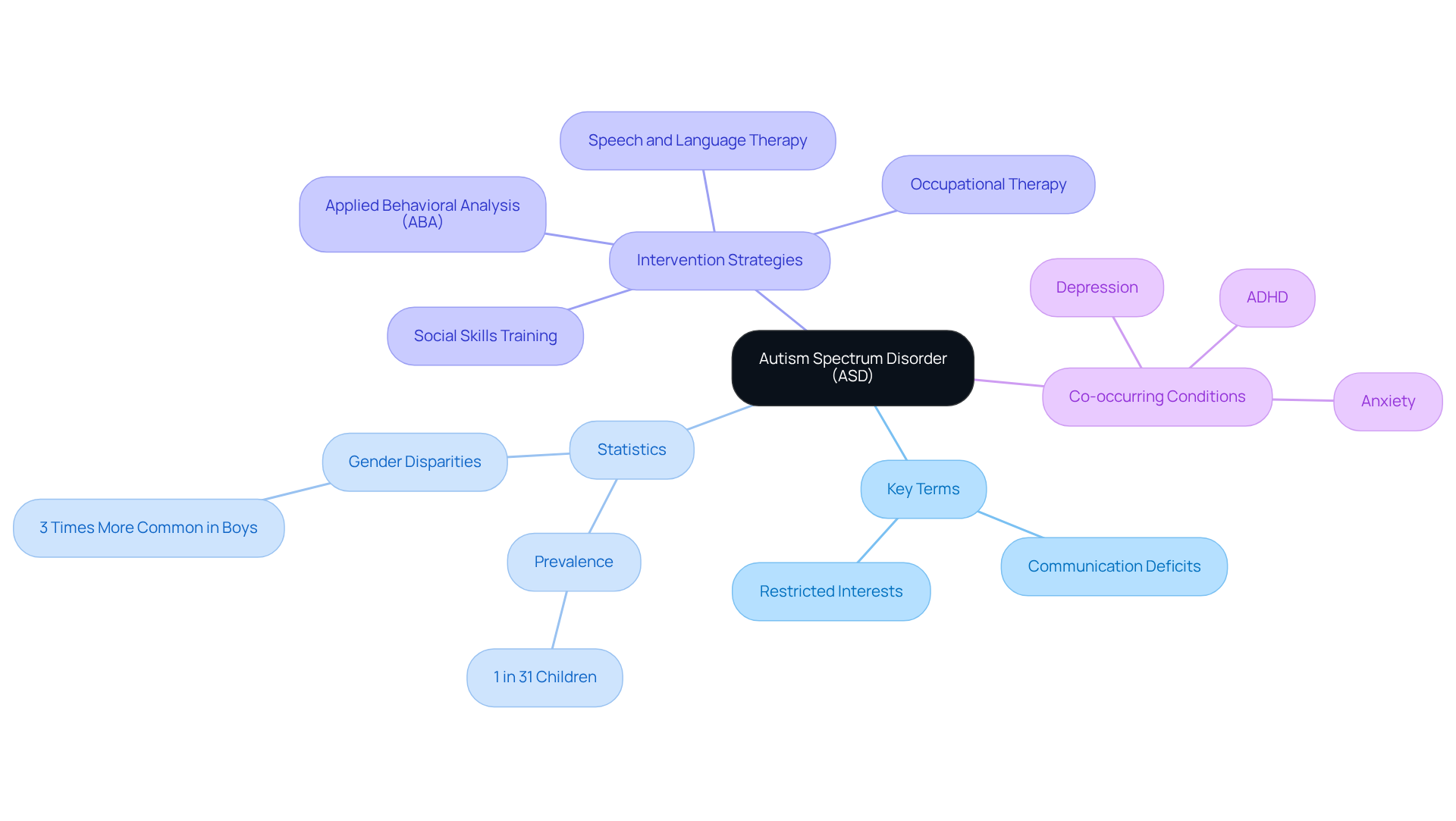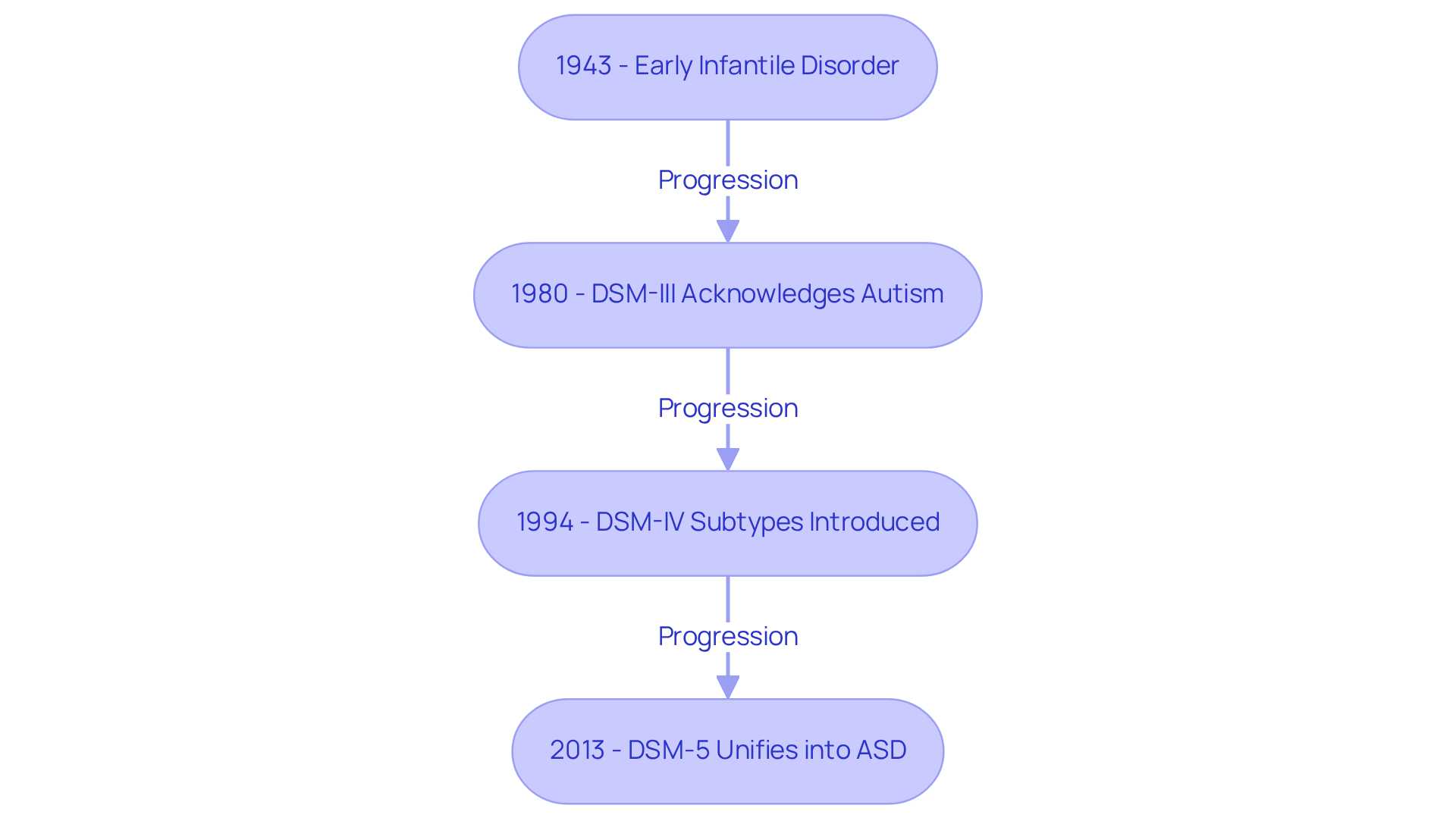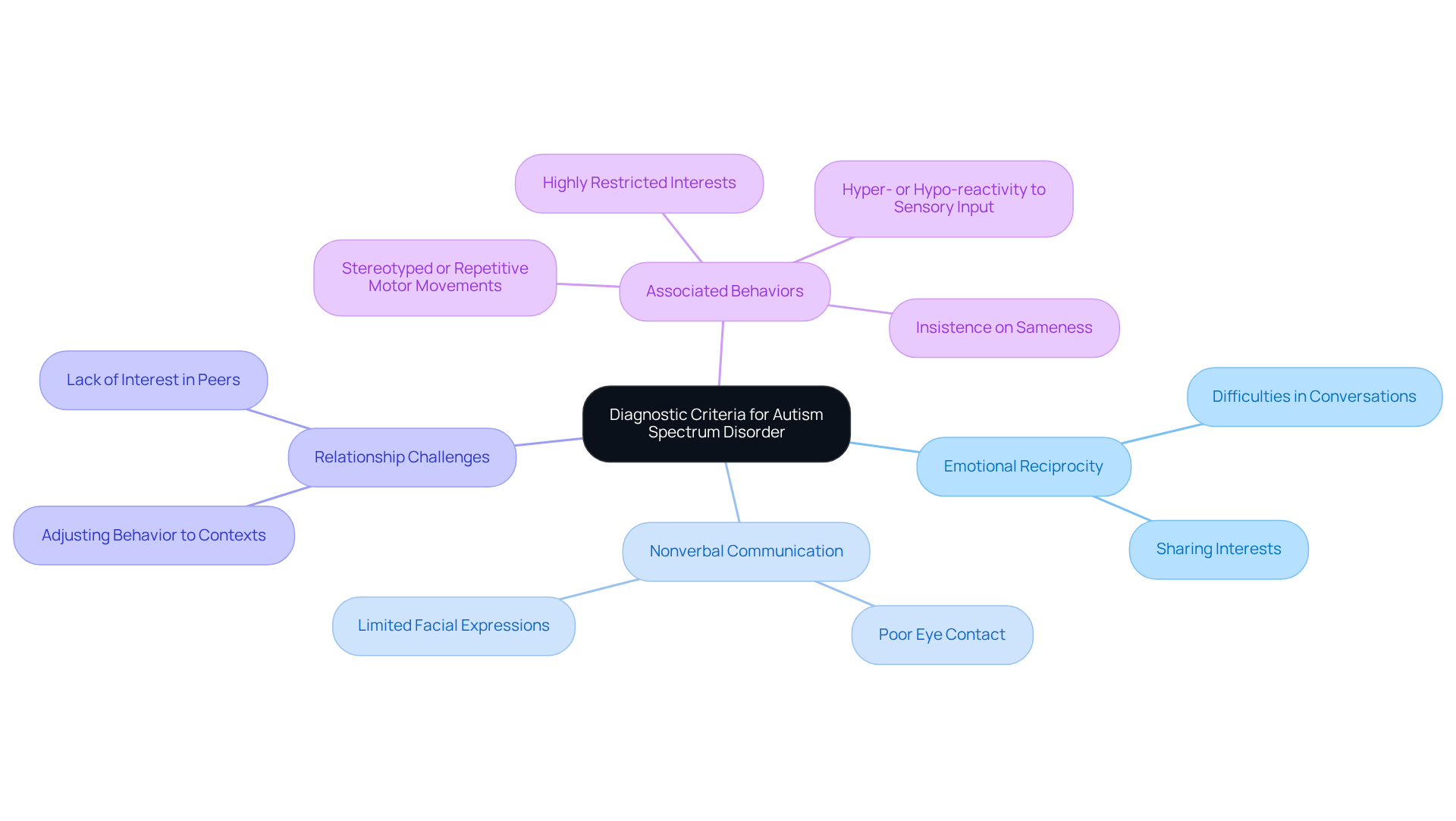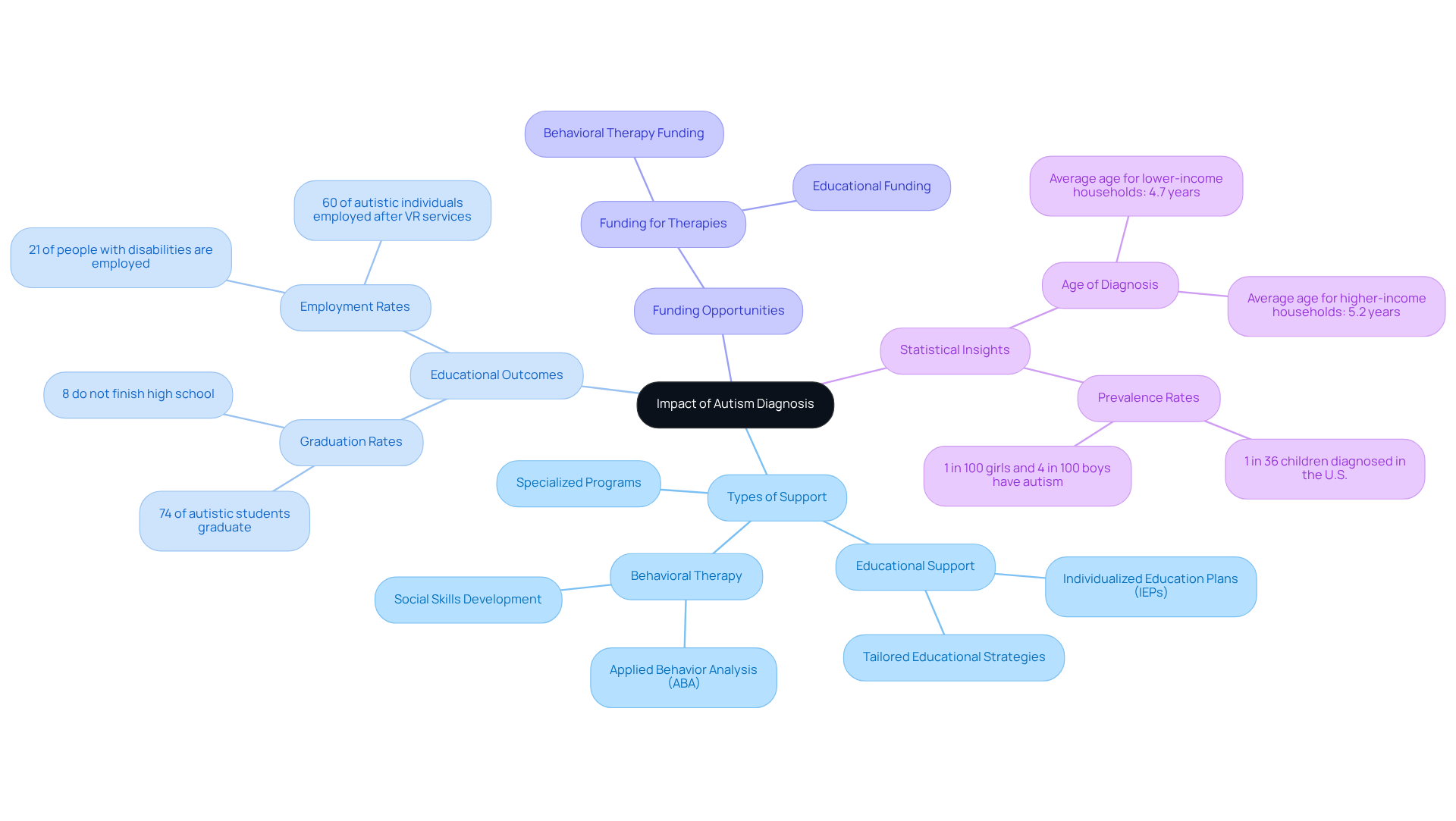Overview
Autism, defined in the DSM-5 as Autism Spectrum Disorder (ASD), encompasses a variety of neurodevelopmental challenges related to communication and behavior, with varying degrees of severity among individuals. Understanding autism is crucial for parents and caregivers who navigate the complexities of this condition.
The article outlines the diagnostic criteria, which include:
- Deficits in social interaction
- Restricted behaviors
It provides a clear view of what ASD entails. It also delves into the historical context and evolution of autism classification, illustrating how our understanding has grown over time. This knowledge is essential for effective intervention and support, empowering families to seek the resources they need. By fostering this understanding, we can create a nurturing environment that promotes growth and development for individuals with autism.
Introduction
Understanding Autism Spectrum Disorder (ASD) within the framework of the Diagnostic and Statistical Manual of Mental Disorders (DSM) reveals a complex landscape that has evolved significantly over the decades. As awareness of ASD continues to rise, recent statistics indicate that approximately 1 in 36 children are diagnosed in the U.S. This highlights the importance of grasping the key concepts and criteria outlined in the DSM, which is paramount for parents, educators, and healthcare professionals alike. But how do these diagnostic criteria translate into real-world support and resources for those affected? This article delves into the nuances of autism as defined in the DSM, exploring its historical evolution, diagnostic criteria, and the critical implications for access to services and support systems.
Define Autism in the DSM: Key Concepts and Terminology
The question of whether autism is in the DSM refers to Autism Spectrum Disorder (ASD), a complex neurodevelopmental condition characterized by ongoing challenges in interpersonal communication and restricted, repetitive patterns of behavior. The DSM-5, the most current edition, emphasizes that autism in the DSM exists on a spectrum. This means individuals may display a wide variety of symptoms and levels of severity. Key terms to understand include 'communication deficits,' which refer to struggles in understanding and participating in interactions, and 'restricted interests,' indicating a deep focus on particular topics or activities.
It’s important to recognize that the occurrence of ASD has significantly increased. Recent estimates suggest that approximately 1 in 31 children in the U.S. has been identified with this spectrum disorder. This rise underscores the necessity for parents and professionals to grasp these terms, as it directly impacts the strategies and interventions they can employ. For instance, effective strategies such as Applied Behavioral Analysis (ABA) and speech and language therapy can substantially enhance adaptive skills and interpersonal interactions. These approaches illustrate the real-world implications of the essential concepts found in the DSM-5, encouraging a proactive stance in seeking support and understanding.

Trace the Evolution of Autism Diagnosis in the DSM
The journey of understanding Autism Spectrum Disorder (ASD) has come a long way, and it's important to recognize how far we’ve progressed. Back in 1943, Leo Kanner first described what he termed 'early infantile disorder,' highlighting significant challenges in social engagement and communication. Fast forward to 1980, the DSM-III officially acknowledged that is autism in the DSM, classifying it within pervasive developmental disorders. By the time the DSM-IV was released in 1994, our understanding had expanded to encompass various subtypes, including Asperger's Disorder and Pervasive Developmental Disorder Not Otherwise Specified (PDD-NOS). Most recently, the DSM-5, published in 2013, clarified that is autism in the DSM by unifying these subtypes into a single diagnosis of Autism Spectrum Disorder (ASD), reflecting a more nuanced view that sees it as a spectrum rather than a collection of distinct disorders.
This evolution is significant, especially as we see the prevalence of developmental disorders rise. Recent data indicates that approximately 2.7% of children in the U.S. are now recognized as having ASD, a notable increase from previous decades. Particularly striking is the 315% rise in ASD identification rates among Hispanic children, highlighting shifting demographics in awareness and diagnosis. The American Academy of Pediatrics recommends developmental screening for all children between 18 to 24 months, underscoring the critical importance of early identification and intervention.
The DSM-5 also introduced concepts of sensory challenges and levels of support, which reflect our evolving understanding of what is autism in the DSM. Importantly, the changes made in the DSM-5 did not reduce autism identification rates; in fact, they may have accelerated them. This ongoing evolution underscores the necessity of continuous research and the importance of adapting diagnostic criteria to better support individuals on the spectrum. By staying informed and engaged, we can foster a more inclusive environment for all families navigating the complexities of ASD.

Examine DSM Diagnostic Criteria for Autism Spectrum Disorder
Understanding Autism Spectrum Disorder (ASD) is crucial for parents and caregivers, as it relates to how is autism in the DSM-5. This guide emphasizes the importance of a comprehensive assessment to ensure that individuals receive the support they need. To qualify for a diagnosis, individuals must show persistent challenges in communication and interaction across various contexts, as well as restricted and repetitive behaviors.
Specifically, the diagnostic criteria highlight three key areas:
- Deficits in emotional reciprocity, which can appear as difficulties in engaging in back-and-forth conversations or sharing interests with others.
- Deficits in nonverbal communication, such as poor eye contact or limited facial expressions, can further complicate interactions.
- Individuals may face challenges in developing, maintaining, and understanding relationships, which might include trouble adjusting behavior to different social contexts or a lack of interest in peers.
In addition to these areas, individuals must exhibit at least two of the following behaviors:
- Stereotyped or repetitive motor movements
- Insistence on sameness
- Highly restricted interests
- Hyper- or hypo-reactivity to sensory input
It’s essential to recognize that these symptoms typically emerge during early developmental periods and can lead to significant impairments in social, occupational, or other critical areas of functioning.
Grasping these criteria is vital for understanding how is autism in the DSM affects parents and professionals alike. Early identification and intervention can profoundly enhance outcomes for children with ASD. For instance, acknowledging the common deficits in social-emotional reciprocity can help guide the diagnostic process and ensure that individuals receive the understanding and support they deserve.
If you’re navigating this journey, know that you’re not alone. Sharing experiences and seeking support can make a significant difference. Let’s foster a community where we can learn from one another and support our children together.

Understand the Impact of Autism Diagnosis on Support and Resources
A diagnosis of a developmental disorder profoundly influences the support and resources available to individuals and their families. It typically unlocks access to essential services, including educational support, behavioral therapy, and specialized programs. For instance, numerous school districts create personalized education plans (IEPs) for students identified with the condition, ensuring that educational strategies are tailored to their specific needs. Furthermore, families may qualify for funding for therapies such as Applied Behavior Analysis (ABA), which has shown effectiveness in enhancing social skills and mitigating challenging behaviors.
However, the availability of these resources can differ significantly based on geographic location and healthcare policies. For example, children from lower-income households are diagnosed at an average age of 4.7 years, which may lead to earlier access to interventions compared to their higher-income counterparts, who are diagnosed at an average age of 5.2 years. The typical age for recognizing these conditions in the U.S. is 5 years, emphasizing the general diagnostic environment. This disparity underscores the importance of understanding the implications of a diagnosis concerning developmental disorders. Parents and professionals must advocate effectively for the necessary support and services to enhance the quality of life for individuals on the spectrum.
Moreover, statistics reveal that approximately 74% of autistic students in the U.S. graduate with a diploma, compared to 86% of all students, while 8% of autistic students do not finish high school. This highlights the critical need for tailored educational support. As the occurrence of the condition continues to rise, with 1 in 36 children diagnosed in the U.S. as of 2023, the necessity for effective educational resources and support systems becomes increasingly vital. Additionally, it is noteworthy that only 21% of people with disabilities, including autism, are employed, emphasizing the long-term implications of educational support on employment outcomes.

Conclusion
Understanding Autism Spectrum Disorder (ASD) within the DSM-5 framework is crucial for recognizing the complexities of this neurodevelopmental condition. Autism is characterized by a diverse range of symptoms and behaviors, highlighting the importance of a spectrum approach rather than a one-size-fits-all diagnosis. This perspective not only helps identify individuals who may need support but also emphasizes the necessity for tailored interventions that can significantly enhance their quality of life.
Throughout this article, we explore key concepts such as communication deficits, restricted interests, and the evolution of diagnostic criteria. The historical journey from early descriptions of autism to its current classification in the DSM-5 illustrates our growing understanding of the disorder. It underscores the significance of early identification and intervention, revealing how these can lead to better developmental outcomes. Moreover, we highlight the impact of a formal diagnosis on access to essential resources, educational support, and overall societal inclusion, which are vital for individuals on the spectrum and their families.
As the prevalence of ASD continues to rise, it is increasingly important for parents, educators, and healthcare professionals to stay informed about the latest diagnostic criteria and available resources. Advocacy for appropriate support and services is essential to ensure that individuals with autism can thrive in various aspects of life. By fostering a community of understanding and support, we can better accommodate the diverse needs of those on the autism spectrum, paving the way for a more inclusive future. Let us work together to create an environment where every individual feels valued and supported.
Frequently Asked Questions
What is Autism Spectrum Disorder (ASD) as defined in the DSM?
Autism Spectrum Disorder (ASD) is a complex neurodevelopmental condition characterized by ongoing challenges in interpersonal communication and restricted, repetitive patterns of behavior.
How does the DSM-5 categorize autism?
The DSM-5 categorizes autism as existing on a spectrum, meaning individuals may exhibit a wide variety of symptoms and levels of severity.
What are some key terms associated with autism in the DSM?
Key terms include 'communication deficits,' which refer to difficulties in understanding and participating in interactions, and 'restricted interests,' indicating a strong focus on specific topics or activities.
What is the prevalence of ASD in children in the U.S.?
Recent estimates suggest that approximately 1 in 31 children in the U.S. has been identified with Autism Spectrum Disorder.
Why is it important for parents and professionals to understand autism terminology?
Understanding autism terminology is crucial as it directly impacts the strategies and interventions that can be employed to support individuals with ASD.
What are some effective strategies for supporting individuals with ASD?
Effective strategies include Applied Behavioral Analysis (ABA) and speech and language therapy, which can significantly enhance adaptive skills and interpersonal interactions.




